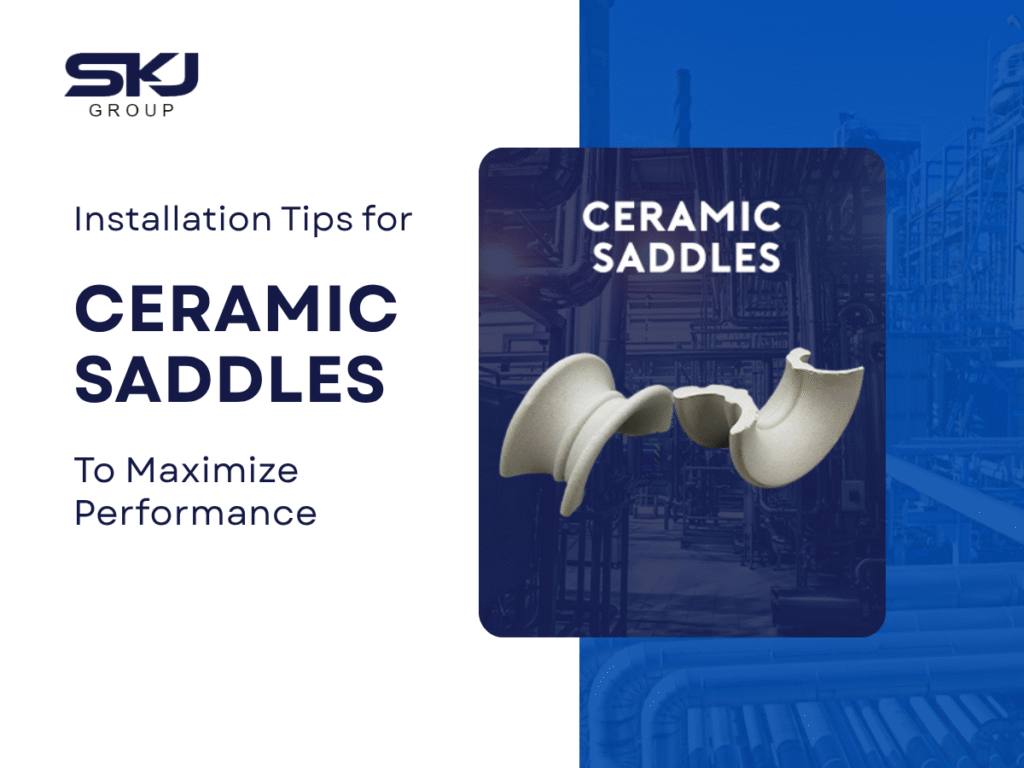Ceramic saddles are essential components in industrial packing systems, especially in distillation, absorption, and chemical processing towers. Their unique design provides excellent gas-liquid contact and enhances mass transfer efficiency. However, even the best ceramic saddles can underperform if not installed correctly.
In this comprehensive guide, SKJ Group USA a leading ceramic saddles manufacturer USA shares proven Tips for Ceramic Saddles installation to help engineers, plant managers, and procurement specialists maximize performance, ensure durability, and minimize downtime.
Understanding the Role of Ceramic Saddles in Tower Packing
Before diving into the installation process, it’s crucial to understand why ceramic saddle packing USA is widely preferred across industries.
Ceramic saddles, also known as Raschig saddle rings, are engineered shapes made from high-strength ceramics designed to maximize the surface area within packed towers. This unique geometry ensures low-pressure drop, excellent mechanical stability, and superior chemical resistance — all vital for efficient mass transfer.
Applications include:
- Chemical processing and petrochemical plants
- Environmental scrubbers and absorbers
- Distillation and rectification columns
- Wastewater treatment and gas absorption units
Why ceramic saddles?
They combine high surface area, mechanical strength, and chemical inertness outperforming plastic and metal alternatives in high-temperature and corrosive conditions.
Key Preparation Steps Before Installing Ceramic Saddles
Proper preparation sets the foundation for successful installation. Many issues such as channeling, uneven flow, and breakage can be avoided with attention to detail before installation.
1. Inspect and Clean the Tower Interior
Before placing the saddles, thoroughly clean the column or tower. Remove debris, rust, or residue that might obstruct uniform flow distribution.
Checklist:
- Inspect tower walls for corrosion or cracks
- Check nozzles, distributors, and supports for blockages
- Ensure even surface for saddle support grid
2. Verify Support Structures
The support grid or plate must be strong enough to hold the weight of the ceramic saddle packing USA. Weak supports can cause uneven load distribution, leading to mechanical damage and inefficient operation.
Ensure that:
- Support beams are level
- There’s no bending or misalignment
- Drainage paths are clear
3. Check for Proper Distribution Systems
Efficient liquid and gas distribution systems are vital for maximizing saddle performance. Uneven flow can lead to dry spots or flooding, both of which reduce efficiency..
Step-by-Step Installation Tips for Ceramic Saddles
Now that preparation is complete, here’s a step-by-step approach to install ceramic saddles correctly for maximum efficiency.
1. Handle with Care
Ceramic saddles are durable but brittle. Improper handling can cause chipping or cracking.
Handling best practices:
- Use gloves when handling
- Avoid dropping or sliding saddles
- Store them on soft surfaces before installation
2. Layer the Saddles Evenly
Uniform distribution is the key to performance. Saddles should not be dumped randomly but layered methodically.
Installation Steps:
- Pour saddles gently from a low height
- Distribute evenly using a rake or shovel
- Avoid compaction — leave natural voids for gas-liquid flow
For larger towers, use mechanical loading equipment to ensure even spreading without damage.
3. Maintain Correct Bed Depth
The depth of the packing bed should be consistent with design specifications. Overpacking or underpacking can change flow dynamics and pressure drops.
Typical bed depths:
- Small towers: 1–2 meters
- Large towers: up to 6 meters per section
4. Check for Voids or Channeling
Once the saddles are installed, inspect for voids, gaps, or channeling paths — areas where gas or liquid could bypass the packing. These create uneven contact and reduce efficiency.
How to avoid it:
- Use redistribution devices between sections
- Conduct test flow to ensure even distribution
Optimizing Tower Performance After Installation
Even after proper installation, ongoing maintenance and performance checks ensure long-term efficiency.
1. Perform Regular Inspections
Inspect saddles periodically for:
- Breakage or attrition
- Chemical buildup or fouling
- Malfunctioning distribution systems
2. Clean Packing When Needed
Scaling or fouling can occur over time due to impurities or chemical reactions. Cleaning the saddles restores performance.
Recommended cleaning methods:
- Backwashing with clean water
- Acid washing (for mineral deposits)
- Steam cleaning for oily residues
3. Replace Damaged Packing Promptly
Broken saddles reduce effective surface area and increase pressure drop. Replace damaged units during routine maintenance shutdowns.
Benefits of Choosing Ceramic Saddles Over Traditional Materials
Ceramic saddles outperform many other types of packing materials, including metal and plastic, especially under demanding industrial conditions.
Advantages of Ceramic Saddles:
- High chemical resistance: Perfect for acidic or corrosive environments
- Thermal stability: Can withstand temperatures above 1000°C
- Low pressure drop: Enhances energy efficiency
- Excellent mechanical strength: Long-lasting and low maintenance
- Environmentally safe: Non-toxic and recyclable
That’s why industries rely on trusted ceramic saddles supplier USA like SKJ Group USA to source quality, precision-engineered products.
How SKJ Group USA Ensures Reliable Ceramic Saddle Packing
As a leading ceramic saddles exporter USA, SKJ Group USA offers precision-engineered saddles designed to meet international standards of performance and reliability.
What sets SKJ apart:
- ISO-certified manufacturing
- Customizable sizes and shapes
- Bulk export capabilities
- Proven track record across 30+ industries
Each batch is quality-checked for uniform density, porosity, and strength to ensure consistent tower performance.
Maintenance Best Practices for Long-Term Performance
Even with perfect installation, ongoing maintenance is key to sustaining performance.
Follow these practices:
- Schedule periodic inspections every 6–12 months
- Check for mechanical wear or thermal cracks
- Ensure redistributors are not clogged
- Monitor pressure drop across the tower
Proper maintenance can extend the operational lifespan of ceramic saddle packing USA by several years.
FAQ’s About Tips for Ceramic Saddles
1. What are ceramic saddles used for?
Ceramic saddles are used as tower packing materials in industries such as petrochemical, chemical, and environmental processing. They enhance gas-liquid contact for absorption, distillation, and scrubbing operations, improving overall mass transfer efficiency.
2. What is the most important part of a saddle?
The curved surface geometry of a ceramic saddle is its most critical feature. This design maximizes contact area while minimizing resistance to fluid flow, ensuring efficient distribution of gas and liquid streams within the column.
3. What are the advantages of using Ceramic Saddles over traditional materials?
Ceramic saddles offer superior chemical resistance, high thermal stability, and mechanical strength compared to metal or plastic packing. They’re ideal for harsh and high-temperature environments, ensuring long service life and consistent performance.
Conclusion:
Correct installation of ceramic saddles is essential for achieving maximum tower performance and efficiency. From preparing the tower to handling and layering the saddles, every step matters.


